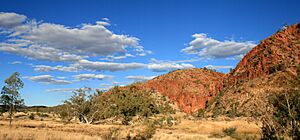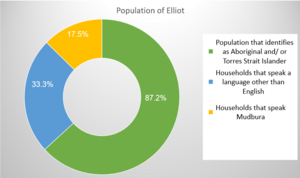Mudburra language facts for kids
Quick facts for kids Mudbura |
|
|---|---|
| Native to | Northern Territory, Australia |
| Region | Victoria River to Barkly Tablelands |
| Ethnicity | Mudbura, Kwarandji |
| Native speakers | 92 (2016 census)aiatsis |
| Language family |
Pama–Nyungan
|
| AIATSIS | C25 |
Mudburra is an Aboriginal language spoken in Australia. It is also known as Mudbura, Mudbarra, or Pinkangama. Some people believe another language, Karrangpurru, might have been a dialect of Mudburra. However, there isn't enough information to confirm this.
The Mudburra language comes from the western Barkly Region and parts of the Victoria River District in the Northern Territory of Australia. The Mudburra people live in areas like Yingawunarri (Top Springs), Marlinja (Newcastle Waters Station), and Kulumindini (Elliott).
In 2016, a census showed that 96 people spoke Mudburra. However, other reports suggest fewer than 10 people speak it fluently. Sadly, children are not learning the traditional form of the language as much anymore.
Contents
About the Mudburra Language
The Mudburra language belongs to the Pama-Nyungan language family. It is part of the Ngumpin-Yapa subgroup. Mudburra has two main dialects: Eastern Mudburra and Western Mudburra. These dialects developed over time as speakers communicated with other language groups. Languages closely related to Mudburra include Gurindji, Bilinarra, and Ngarinyman.
Mudburra History
Before Europeans arrived, the Mudburra people moved around with the seasons. They lived near the Murranji stock path and the eastern side of the Victoria River. Their land was very dry, so they traveled long distances to find food and water.
In the mid-1800s, Europeans came to the Barkly and Victoria River areas. Explorers like Augustus Charles Gregor and John McDouall Stuart explored these lands. Stuart named a water source "Newcastle Water" after a duke. He noticed that Mudburra people often used this spot for water and food.
Later, in 1883, large cattle stations like Newcastle Waters Station were set up. This meant the Mudburra people were pushed off their traditional lands. The new farming methods changed their environment and resources. To survive and avoid conflict, many Mudburra people moved to the stations to work. They worked as domestic helpers or station workers, often for very little food or unfair wages. Mudburra became the main language spoken at Newcastle Waters Station.
The Mudburra people built special shelters called 'nanji'. These shelters were made from bark from lancewood trees. A nanji had a low door but was tall enough inside for an adult to stand up. It could fit up to six people and had beds made from local grasses.
In the 1900s, Aboriginal workers created a new language called Kriol. It combined Aboriginal languages with English. This helped them talk with Europeans. Kriol spread to the Mudburra community and is still spoken there today.
Mudburra Today
Most Mudburra people now live in Elliott, a small town between Darwin and Alice Springs, or in Marlinja. In 2016, Elliott had 339 residents. The Mudburra language is now at risk of disappearing. Most people in Mudburra communities speak Aboriginal English or Kriol. Only a few elders still speak the traditional Mudburra language.
Connections to Other Languages
Before Europeans arrived, Mudburra speakers often knew several other Aboriginal languages. These included Gurindji and Jingulu. Eastern Mudburra speakers lived near Jingulu speakers. Because of this, their cultures and languages shared many features. They also borrowed many words from each other. Western Mudburra speakers lived closer to the Gurindji community. They shared some features with Gurindji that were different from Eastern Mudburra.
One researcher, Pensalfini, noted that the mixing of Mudburra and Jingili people created a new cultural group. They called themselves 'Kuwarrangu', which was different from both Jingili and Mudburra.
How Mudburra Sounds
The Mudburra alphabet uses the same letters as English, but some sounds are different.
Vowels
Mudburra has three main vowel sounds: a, i, and u.
- The letter a sounds like the "a" in "father".
- The letter i sounds like the "i" in "bit".
- The letter u sounds like the "u" in "put".
Some vowel combinations create different sounds, like "aw", "ay", "iyi", "uwu", "uwa", and "uwi".
Consonants
Some consonants, like b, d, k, and j, are pronounced differently than in English. Other consonants sound similar to English. Common consonant combinations include: "rd", "rn", "rl", "ng", "ny", "ly", and "rr". The "rd" sound is special; it's like rolling the "r" sound combined with a "d".
Mudburra Grammar
Mudburra grammar has interesting ways of forming words and sentences.
Verbs
In Mudburra, there are verbs and coverbs. Verbs change their endings based on their role in a sentence. These changes are called "inflections". There are four main inflections:
- Imperative verbs: These are commands (e.g., "leave it!").
- Past tense verbs: These describe actions that already happened (e.g., "left it").
- Present tense verbs: These describe actions happening now (e.g., "leaves it").
- Potential verbs: These describe actions that will happen (e.g., "will leave it").
Verbs fall into five different conjugations, each with its own set of endings. Here are some examples:
- Group 1A: wanjarra (leave it!), wanjana (left it), wanjanini (leaves it), wanjarru (will leave it)
- Group 1B: warnda (get it!), warndana (got it), warndanini (gets it), warndu (will get it)
- Group 2A: yinba (sing it!), yinbarna (sang it), yinbarnini (sings it), yinba (will sing it)
- Group 2B: janki (burn it!), jankiyina (burnt it), jankiyini (burns it), janki (will burn it)
- Group 3: ngardangka (abandon it!), ngardangana (abandoned it), ngardanganini (abandons it), ngardangangku (will abandon it)
- Group 4: nganja (eat it!), ngarnana (ate it), ngarnini (eats it), ngalu (will eat it)
- Group 5: yanda (go!), yanana (went), yanini (goes), yandu (will go)
Coverbs
Coverbs are words that go with verbs. They show that an action is ongoing or continuous. Some coverbs only work with certain verbs. Coverbs can also have different endings that change their meaning.
Demonstratives
In Mudburra, you don't always need words like "a" or "the" before nouns. Instead, they use "demonstratives" like "nginya" (this) and "yali" (that one close up). There are four main demonstratives:
- nginya (or minya): means this (one)
- yali: means that (one) long way away
- kadi: means that (one) close up
- kuwala: means like this
Demonstratives can have different endings, similar to how nouns change in different "cases" in Mudburra. These cases include:
- Nominative: for the subject of a sentence.
- Ergative: for the person or thing doing the action.
- Dative: for the person or thing something is for.
- Locative: for where something is.
- Allative: for to where something is going.
- Ablative: for from where something is coming.
Demonstratives can also have endings that show quantity, like "-rra" for many or "-kujarra" for two.
Pronouns
Mudburra has three types of pronouns: bound pronouns, free pronouns, and indefinite pronouns.
- Bound pronouns are often attached to other words. They show who is doing or receiving the action. They don't have a third-person form (he/she/it).
- Free pronouns are used to emphasize a person. They also have possessive forms to show ownership.
- Free pronouns:
- ngayu, ngayi / I, me
- nyundu / you
- nyana / he, him, she, her
- Possessive pronouns:
- ngayinya / my, mine
- nyununya / your, yours
- nyanunya / his, her, hers
- Free pronouns:
- Indefinite pronouns refer to unknown objects or people. Examples include:
- nyamba (something)
- ngana (someone)
- nganali (someone did it)
- nyangurla (sometime)
- ngadjanga (some amount)
- wanjuwarra (somewhere)
Quantity Endings
To show how many of something there are, Mudburra uses endings added to words. For example:
- "-kujarra" means two
- "-darra" or "-walija" means many
Sentences
Mudburra sentences are flexible. The order of words can change. Noun phrases can even be split up, as long as all the words in the phrase have the same grammatical case.
Sentences can be:
- Intransitive: No object (e.g., "He runs.").
- Transitive: Has a subject and an object (e.g., "She eats the apple.").
- Semi-transitive: Has a subject and an indirect object.
- Ditransitive: Has a subject, an object, and an indirect object.
To show possession, you can use pronouns. For body parts, bound or free pronouns are used. For things you own, possessive pronouns are used.
Negative sentences use the word "kula" with the verb. "Kula" means something is not, was not, or will not happen. It usually comes at the beginning of the sentence or right after the first word. Other words like "-mulu" (don't), "wakurni" (no or nothing), and "-wangka" (without) also show negativity.
For more complex sentences with more than one clause, linking words or endings are used. Examples include:
- "-baa" and "-maa": mean when, if, which, who
- "abala": means when, that, while, which, then
- "amba": means so that, that, which, while
The word "and" doesn't exist in Mudburra. Words are either listed one after another without a linking word, or some of the linking words above are used.
Mudburra Words
Here are some common words and phrases in Mudburra.
Common Question Words
- nyamba / what?
- nyambawu / why?
- ngana / who?
- nganawu / whose?
- wanji / which?
- wanjuwarra / where?
- ngadjanga / how much? or how many?
- nyangurla / when?
- ngadarra / how?
Indicating Direction
- kankulu / up, above, on top of
- kanju / down, under, on the bottom, underneath, in
- kirrawarra / north
- kurlarra / south
- karlarra / west
- karrawarra / east
Numbers
Mudburra only has words for the first three numbers:
- nyangarlu / one
- kujarra / two
- murrkuna / three
- dardudardu / more, many, a whole lot
Mudburra Sign Language
The Mudburra people also have a well-developed signed form of their language called "Marnamarnda". This sign language can be used with spoken words or by itself. Mudburra people use it for things like hunting or communicating over long distances.



